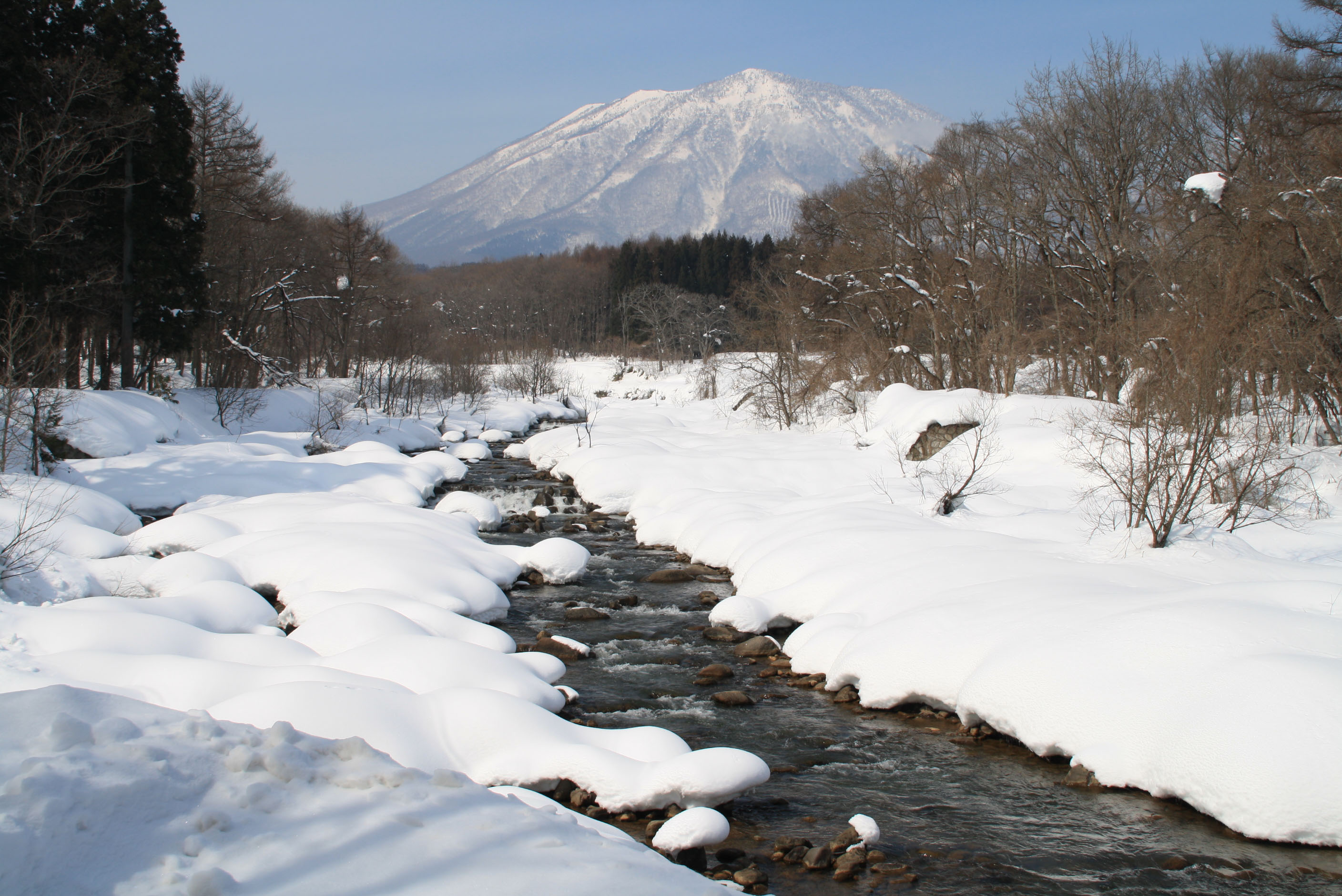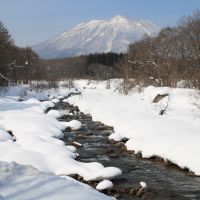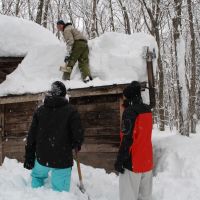The winter of 1946-47 saw record snowfalls in Britain. As a 7-year-old boy in hilly Wales, it was sheer joy — and never mind the transport shutdown and electricity crisis as power stations ran out of coal.
We went tobogganing, we had great snowball battles and, with a little help from my grandfather, I built a snowman in the backyard that towered almost 2 meters high. He had little coal lumps for eyes, a carrot for his nose and a row of shiny black coal teeth. He wore one of Grampa's old cloth caps at a jaunty angle, and had a scarf around his neck. I'll never forget that snowman.
I finally settled here in Nagano Prefecture in the autumn of 1980. That winter brought snows that I could not have imagined as a child in Britain. We had rented a big old thatched country house. When snow piled up over a meter deep on the roof, the whole building would creak and groan, and you couldn't get the sliding screens or doors to budge because their frames were out of kilter.
That meant I had to go up onto the roof and shovel off the snow. During the winter of 1980-81, I had to do that 12 times, and on each occasion it took at least two days. As the snow rose up to be way higher than the eaves, though, I also had to open a clear gap below the eaves to prevent the snow hills from freezing to the thatch and bringing it all off.
When I built my own house, which was finished in the early winter of 1982, I designed the roof so that the snow would slide off by itself. I also gave it a raised "basement" so that snow piling up from off the roof would not block the view from the living-room windows. However, when I built the sauna at the back, with an open-sided but roofed-over outside bath, I didn't give that smaller building a steep roof. So, when snow piles up, somebody has to get up there and shovel it off. The same goes for the garage roof.
In early January this year, I had the pleasure of hosting three Australian lads who came for the skiing and snowboarding. Just after Christmas I had been up on the roofs of both the sauna and the garage shoveling snow, but the stuff just kept falling and falling. If anybody had built a snowman, the poor thing would have been buried within a few nights.
As a rule, depending on beds and floor space available, I generally have lads visiting from around the world to pitch in and help out. Although my recent Australian guests had never done yuki oroshi (literally, "snow-dropping"), as rooftop snow-shoveling is called, they were quite happy to pitch in, twice, during the time they stayed with me.
In that first winter 30 years ago in Nagano, I had no need of even such willing helpers because back then I had just turned 40 and was pretty fit. So, though it took a lot of time, shoveling snow all day was no great hardship — and in truth I enjoyed the good outdoor exercise. Now that I'm no longer a spring chicken, though, I am very glad indeed that the snow falls off the main roof of the house by itself.
Of course I still shovel the stuff, and will get up again on the sauna and garage roofs to do so — but what was easy at 40 can be hard work at 70. My heart therefore really goes out to all the older folk around here, and in other areas of Japan, where the snow lies deep and heavy.
There has been an exodus of younger people from the countryside, so it is now older folk who do most of the farming — and the snow-shoveling. So far, in our little town of Shinano (the station is called Kurohime, after the mountain), there have been two fatalities this winter among the population of just under 10,000, as well as several injuries sustained by people removing snow from roofs. I heard recently that throughout Japan's yukiguni (snow country) this winter, more than 100 people have died to date — with hundreds more injured — in snow-related accidents, most of which happened while they were removing snow from roofs.
In the first week of February, snow was lying about 1½ meters deep around my house, though as the weather warms, or when we get rain, it compacts. When I bought land here, I deliberately sought an area with less snow than most. Up nearer the Kurohime ski slopes, where our forester Mr. Matsuki lives, there is now more than 3 meters of snow on the ground. That's a lot of shoveling, and although Mr. Matsuki is as tough as they come, he's 76 years old. One old guy in a neighboring town had a heart attack while clearing snow off his roof — he was 87 seven years old! After a long, full life, that's not fair!
Nonetheless, if snow is left to keep piling up on a roof it will collapse and the walls will get pushed in. This is happening to hundreds, if not thousands, of vacant houses and buildings, and to the homes of old folk who are just too infirm to get out there with a shovel.
I don't begrudge folk their fun, and around here we welcome guests and visitors who come to play in the snow — after all, snow-related tourism is essential to our Nagano economy. However, wouldn't it be even more rewarding all round if there was a system enabling healthy young visitors to spend a day or so clearing snow in return for free ski-slope passes, or a local dinner with beer and sake — or just the friendship and gratitude of the old folk?
Something would have to be done about insurance, but that's not so hard to work out. The going rate for a snow-shoveler in this area used to be ¥15,000 and a large flagon of sake per day. With free lodging and food, that might be the makings of a great working holiday.
Let's go even further: Why not have snow-shoveling adopted as an Olympic winter sport?
Meanwhile, it's a fine day today, and looking out of my study window at Mount Kurohime, all silver with snow, and at the Torii River running crystal-clear between high snow banks, I feel privileged and happy to live here.
Another great advantage of the long cold snowy days and nights is that the potatoes, carrots, cabbages, parsnips — and even the apples and oranges I store in the back kitchen — taste so sweet. Near-freezing temperatures cause the starches in these vegetables and fruits to convert to sugars. As a result, our ordinary potatoes are sweeter than sweet potatoes at this time of year.
In fact, communities in Hokkaido, the northeastern Tohoku region and Niigata Prefecture along the Sea of Japan take advantage of the heavy snowfalls there to build snow-packed warehouses for keeping food fresh well into the summer. Snow gathered in winter and stored in well-insulated constructions is also used to cool old-folks' homes, schools and hospitals.
In addition, another very good idea I heard recently was that supercomputers — which generate tremendous amounts of heat — should be sited in areas of heavy snow in purpose-built "snow-fridge" buildings that could be used to keep them cool throughout summer as well as winter, and so greatly reduce the extremely high costs in electricity needed for this task.
It will be hard to persuade our small town to follow suit, and to use the snow to save energy, because already it, like many others this winter, has gone way over budget in snow-clearing and removal costs, and has had to ask the central government for help. I'll keep nagging though — and if a supercomputer were to come our way, perhaps we wouldn't have to go cap in hand again.





















With your current subscription plan you can comment on stories. However, before writing your first comment, please create a display name in the Profile section of your subscriber account page.